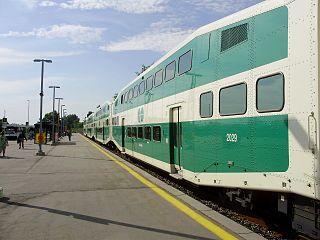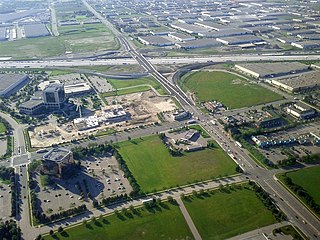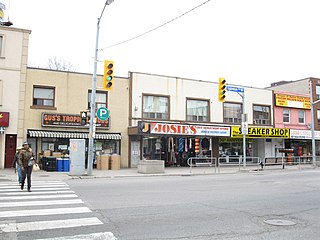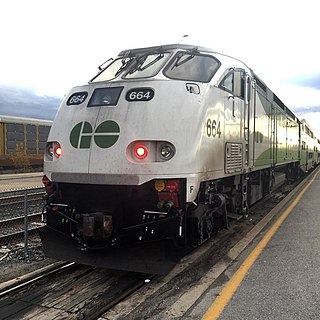
GO Transit is a regional public transit system serving the Greater Golden Horseshoe region of Ontario, Canada. With its hub at Union Station in Toronto, GO Transit's distinctive green and white commuter rail trains and coach-style buses serve a population of more than seven million across an area over 11,000 square kilometres (4,200 sq mi) stretching from Brantford and Kitchener in the west to Newcastle and Peterborough in the east, and from Barrie in the north to Niagara Falls in the south. GO Transit carried 68.5 million passengers in 2017, and its ridership continues to grow. GO Transit operates diesel-powered double-decker trains and coach buses, on routes that connect with all local transit systems in its service area, as well as Via Rail, Canada's national rail system.

The Milton line is one of the seven train lines of the GO Transit system in the Greater Toronto Area, Ontario, Canada. It extends from Union Station in Toronto to Milton, by way of Mississauga.

Kitchener is one of the seven train lines of the GO Transit system in the Greater Toronto Area, Ontario, Canada. It extends from Union Station in Toronto to Kitchener, though most trains originate and terminate in Brampton in off-peak hours.

Barrie is one of the seven train lines of the GO Transit system in the Greater Toronto Area, Ontario, Canada. It extends from Union Station in Toronto in a generally northward direction to Barrie, and includes ten stations along its 101.4 kilometres (63.0 mi) route. From 1982 to 1990 and again from 1993 to 2007, it was known as the Bradford line, named after its former terminus at Bradford Station until the opening of Barrie South Station.

The Union Pearson Express is an airport rail link running between Union Station in Downtown Toronto and Toronto Pearson International Airport. The UP Express began operation on 6 June 2015, in time for the 2015 Pan American Games. The UP Express travels between Union and Pearson in 25 minutes departing every 15 minutes, seven days a week. At the launch announcement, it was stated that the UP Express was projected to carry 2.35 million passengers annually and eliminate approximately 1.2 million car trips in the first year.
The Relief Line was a proposed rapid transit line for the Toronto subway system, intended to provide capacity relief to the Yonge segment of Line 1 and Bloor–Yonge station and extend subway service coverage in the city's east end in the first phase.

The Big Move is the regional transportation plan (RTP) published by Metrolinx for the Greater Toronto and Hamilton Area (GTHA) in Ontario, Canada. It makes specific recommendations for transit projects, resulting from seven "green papers" and two "white papers" released for public discussion. A draft RTP was released alongside draft investment strategy in September 2008. After a series of stakeholder consultations and public meetings, the final RTP was approved and published by Metrolinx on November 28, 2008.

Metrolinx is a Crown agency that manages and integrates road and public transport in the Canadian province of Ontario, specifically in the Golden Horseshoe region and Ottawa. Headquartered at Union Station in Toronto, the agency was created by the Government of Ontario as the Greater Toronto Transportation Authority on April 24, 2006. The agency adopted its present name as a brand name in 2007 and eventually as the legal name in 2009.

Transit City was a plan for developing public transport in Toronto, Ontario, Canada. It was first proposed and announced on 16 March 2007 by then-Toronto Mayor David Miller and Chair of the Toronto Transit Commission (TTC) Adam Giambrone. The plan called for the construction of seven new light rail lines along the streets of seven priority transit corridors, which would have eventually been integrated with existing rapid transit, streetcar, and bus routes. Other transit improvements outlined in the plan included upgrading and extending the Scarborough RT line, implementing new bus rapid transit lines, and improving frequency and timing of 21 key bus routes. The plan integrated public transportation objectives outlined in the City of Toronto Official Plan, the TTC Ridership Growth Strategy and Miller's 2006 election platform.
The Don Mills LRT was a proposed light rail line in Toronto, Ontario, Canada. It was part of the Transit City proposal announced March 16, 2007, to be operated by the Toronto Transit Commission (TTC). It was expected to cost approximately $675 million, with construction to begin in 2012, and an expected opening in 2016. It would have been the fifth of the seven Transit City lines to be complete after the Sheppard East, Finch West, Waterfront West, and Eglinton lines. Ridership was estimated to be 21.2 million trips in 2021.

The Hurontario LRT is a under construction light rail line in Mississauga, Ontario, Canada, that extends into Brampton, Ontario. This line will run along Hurontario Street. The line will be built and operated by a consortium of private European and Japanese companies. As of 2010, it was likely that Metrolinx would own the line.

The BLAST network is a plan for a frequent rapid transit system in the city of Hamilton, Ontario, Canada. It was conceived as part of the city's 2007 transportation master plan. It was later incorporated by Metrolinx as part of its regional transportation plan, The Big Move. The B-Line LRT and A-Line are among the plan's prioritized transit expansion projects and were funding by the Government of Ontario in May 2015.

The A-Line is a planned bus rapid transit line running along James Street in downtown and Upper James Street on the escarpment in Hamilton, Ontario. It is part of Hamilton's proposed BLAST network, involving four other rapid transit corridors. It is identified by Metrolinx in its regional transportation plan The Big Move as a project to be completed by 2023. The route is currently served by Hamilton Street Railway's Route 20 A-Line Express bus.

Oakwood is an underground light rail transit (LRT) station under construction on Line 5 Eglinton, a new line that is part of the Toronto subway system. It will be located in Little Jamaica at the intersection of Oakwood Avenue and Eglinton Avenue. It is scheduled to open in 2022.
Dundas Street Bus Rapid Transit (BRT) is a bus rapid transit corridor proposed by Metrolinx through the regional transportation plan The Big Move. The City of Mississauga is using the brand Dundas Connects during the development phase.
A Bus rapid transit (BRT) corridor is proposed on Highway 427 as part of Metrolinx's regional transportation for the Greater Toronto and Hamilton Area, The Big Move. This BRT line would be established in two separate segments. The southern segment would begin at the Toronto Transit Commission's Kipling station on Line 2 and proceed north along Highway 427 to Renforth station, the eastern terminus of the Mississauga Transitway. This southern segment would help augment the existing 900 Airport Rocket bus service. The northern segment would start at Toronto Pearson International Airport, and proceed non-stop to bus rapidways on Highway 7 in York Region and Queen Street in Brampton.
A rapid transit corridor on Brant Street has been proposed in Burlington, Ontario. Metrolinx has proposed the corridor in their regional transportation plan The Big Move in two separate segments:
The Big Move is a regional transportation plan (RTP) published in 2008 and consisting of 62 rapid transit projects to be implemented across the Greater Toronto and Hamilton Area (GTHA). These rapid transit projects are intended to form a seamlessly integrated regional rapid transit network, which is the first priority action in the regional transportation plan. These projects form two long-term templates with 15 and 25 year horizons. These templates outline broad projects; specific details about technology, alignment, stations and service levels for each project are subsequently determined though a cost–benefit analysis, or an environmental assessment process.
Regional Express Rail (RER), also known as GO Expansion, is a project to improve GO Transit train service by adding all-day, two-way service to the Barrie line and the inner portions of the Kitchener line and the Stouffville line, and by increasing frequency of train service on various lines to as often as every 15 minutes on five of the corridors. This would be achieved with the full electrification of the Lakeshore East line and the Barrie line and the electrification of the inner portions of the Lakeshore West line, the Kitchener line, and the Stouffville line. RER is one of the Big Move rapid transit projects.

GO Transit rail services are provided throughout the Greater Toronto and Hamilton Area (GTHA) and the Greater Golden Horseshoe. The GO Transit rail fleet consists of 75 MPI MP40 locomotives and 678 Bombardier BiLevel Coaches.












